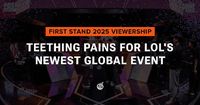The League of Legends (LoL) esports scene is undergoing significant attention as it grapples with varying challenges and milestones, particularly highlighted by the First Stand 2025 tournament. Hanwha Life Esports marked a historic moment by securing its first international trophy, yet the event's viewership numbers revealed an unexpected shortfall in audience engagement.
Despite reaching an admirable 1.1 million peak viewers during the Grand Final, overall metrics were below expectations, with the tournament accumulating just over 18 million hours watched (HW). This figure contrasted sharply with pre-tournament predictions, which estimated that First Stand 2025 would rake in at least 40 million hours. The significant drop—exceeding 200%—raised eyebrows among fans and stakeholders alike.
Several factors contributed to these disappointing statistics. For one, the First Stand was held in Korea, which imposed inconvenient time zones on Western audiences. As a result, many potential viewers were faced with early morning or late-night livestreams that likely limited participation. Moreover, the absence of popular teams such as T1 and LOUD left a noticeable gap in regional representation, specifically resonating with the Portuguese-speaking community that was notably absent.
Riot Games aimed to ignite regional rivalries with the introduction of First Stand 2025, but its impact paled in comparison to established competitions like the Mid-Season Invitational (MSI) and the World Championship. These legacy events not only capture the fans’ attention but are crucial as the season nears its pinnacle, particularly as teams vie for slots in the prestigious Worlds tournament.
Historically, the stakes are highest as the competitive season winds down. Fans are typically more engaged when there’s a clear path for their teams to succeed on a grand scale. Even though the prize pools at First Stand were higher than usual, they did not compensate for the lack of high-stakes competition that fans primarily seek.
A trend in viewership dynamics can be observed when comparing this novel tournament to the MSI from the previous year. At MSI 2024, teams significantly boosted their viewership numbers, averaging over two times the views during main rounds, with some teams experiencing as much as tenfold increases. Conversely, following First Stand 2025’s qualifiers, while teams did experience a 167% increase in audience engagement on average for the main event, it still felt underwhelming compared to these historical benchmarks.
Even Hanwha Life Esports experienced a drop in its average viewer count, which decreased by 2% compared to its recent performance in the LCK Cup 2025. The team's previous appeal was amplified by the presence of T1, whose star players naturally draw larger crowds irrespective of their opponents.
In contrast, Karmine Corp (KCB), who reached the Grand Final, found themselves in a better position regarding viewer engagement, achieving only a 31% rise in average viewers compared to their record-breaking LEC Winter performances. This indicates that the teams present play an essential role in shaping overall viewership dynamics, with legends like Lee "Faker" Sang-hyeok being pivotal in generating fan interest.
The dynamics surrounding audience engagement extend beyond the teams competing and into their air timings as well. Ritualistic viewing experiences are essential, particularly for massive global communities that deeply engage with LoL esports.
Looking ahead, Riot announced a $5 million prize pool for the upcoming League of Legends World Championship 2025 in their interview on March 16, 2025. This prize pool stands to more than double the $2.225 million from the previous year’s tournament, which last year shattered records by attracting 6.94 million viewers for the Grand Final showdown between Bilibili Gaming and the eventual victor, T1.
However, format changes are also in place for Worlds 2025, including reducing the team slots from 20 to 17, indicating a strategic shift aimed at refining the competitive landscape. Riot’s approach to maintain or increase viewer interest is notable because, while it introduces sizeable monetary incentives, it must also consider the overarching structure of tournament formats.
In line with expectations for upcoming tournaments, the Mid-Season Invitational (MSI) is set to take place in Vancouver, Canada, from June 27 until July 12, 2025, boasting its own $2 million prize pool. With tournaments underway, the esports community anticipates how these changes will unfold.
As Chris Greeley, the Global Head of LoL Esports, mentioned, "The goal of LoL Esports is not to become a profitable esports. We are focused on building a sustainable ecosystem.” His statement underscores the long-term vision for a thriving professional and amateur esports community.
Reflecting on the past fifteen years, Greeley portrayed a positive outlook as they aim for the next thirty. As esports gently shifts and adapts, the industry is sure to observe numerous advancements and challenges that will require thoughtful adjustments moving forward.
In conclusion, the path for LoL esports is an intricate web of competition, audience engagement, and strategical developments that will likely shape the narrative of this popular gaming ecosystem for years to come.






